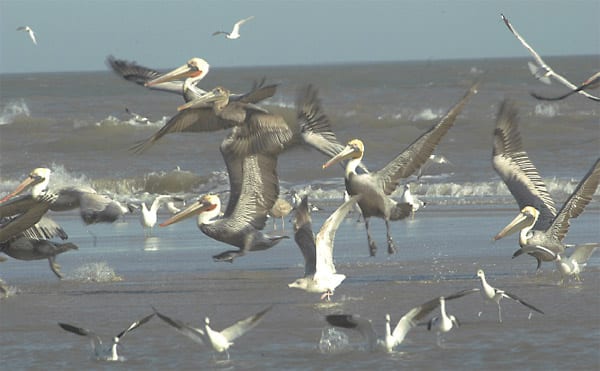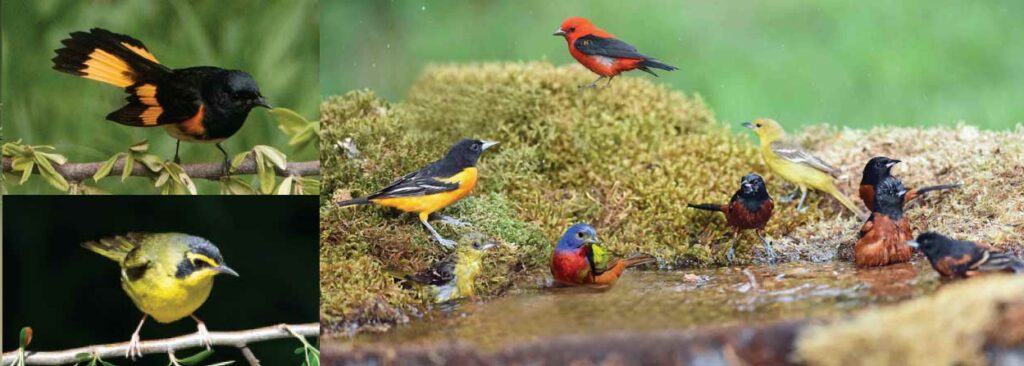 We are a group of friends of all ages, centered in Galveston County, Texas,
stretching to other countries, who share a love for learning about birds. We
have get-togethers, classes and birding trips like the Water Bird Workshop
or Shorebird Seminar. Members have day and overnight field trips to observe
birds in their natural setting. The Society offers several trips away from
Galveston during each year. Participants have gone to far away bird hot
spots such as Venezuela, Arizona, South Texas, Florida, Alaska, the Yucatan,
the Galapagos and many other locations. Additional trips planned for the
future include Africa, Tierra del Fuego and Cape May. The leader of the
trips is Jim Stevenson, who is a professional bird guide and ornithology
professor. Leaders of the Society are available for providing programs and
articles about birds and other animals for newspapers and periodicals.
Executive Director, Jim Stevenson, has written several books, including the
ninth chronicling the Birdlife of Galveston.
We are a group of friends of all ages, centered in Galveston County, Texas,
stretching to other countries, who share a love for learning about birds. We
have get-togethers, classes and birding trips like the Water Bird Workshop
or Shorebird Seminar. Members have day and overnight field trips to observe
birds in their natural setting. The Society offers several trips away from
Galveston during each year. Participants have gone to far away bird hot
spots such as Venezuela, Arizona, South Texas, Florida, Alaska, the Yucatan,
the Galapagos and many other locations. Additional trips planned for the
future include Africa, Tierra del Fuego and Cape May. The leader of the
trips is Jim Stevenson, who is a professional bird guide and ornithology
professor. Leaders of the Society are available for providing programs and
articles about birds and other animals for newspapers and periodicals.
Executive Director, Jim Stevenson, has written several books, including the
ninth chronicling the Birdlife of Galveston.
The most important step for anyone is to e-mail Jim at galornsoc@earthlink.net and ask to be placed on the list to receive the GOS announcements and bird PDFs. These twice-a-week collections teach members about birds (sometimes other animals) and inform members of activities and opportunities. Nobody will get your e-mail and you can get off any time. View our special 5-part Winter Waterbirds series here.
NEW! Spring Warbler Photo Blind PDF



































Bird Photography Opportunities

January, Rio Grande Valley
The Rio Grande Valley trip is a four-day, whirlwind tour of many of the terrific spots for birds in South Texas. We leave around dawn on Thursday and drive to Harlingen, where we will hotel for the duration of the trip. Then we head out to Laguna Atascosa NWR for afternoon birding, before calling it a day.
March, Costa Rica
We have three wonderful and separate weeks in Costa Rica. Week one, the “Western Loop,” we head over to the Pacific Coast and begin with the Tarcoles area. Included in this is the town itself, with Turquoise-browed Motmots, a boat ride into the mangroves with Boat-billed Herons, a Canopy Walk down the side of the mountain, with many mid-range tropical species, and fabulous Carara National Park.
March, Big Bend (West Texas)
We often run a spring break trip in mid-March to several places in West Texas, with the top destination being Big Bend National Park. On Thursday, however, we leave the Galveston/Houston area very early, arriving midafternoon in Balmorhea. We visit the Lake and the State Park for birds like roadrunner and Vermilion Flycatcher, then move on to the highway that heads south toward Big Bend National Park. However, we stop for a visit at Davis Mountain State Park, where feeders bring many neat bird species close.
April, UTC
Jim and the GOS run two birding programs in April that are the best activities of the entire year. One is pure birding, visiting virtually every good birding site on the UTC. Places include Sabine Woods, High Island, Anahuac, Brazoria and San Bernard NWR, Quintana Neotropical Sanctuary, Bolivar Flats, Galveston’s Lafitte’s Cove Nature Preserve and San Luis Pass, Texas City Dike, Brazos Bend State Park and of course, Jim’s amazing property. We’ll see around two hundred species from brilliant warblers to exquisitely-colored shorebirds, and spend five days in delightful, spring weather. You are welcomed to bring a hand-held camera, but the emphasis will be on bird watching.
June, Great Plains/Rockies
One of our most favorite trips during the year is the Plains/Rockies Trip, which runs from the Great Salt Lake in Utah to North Dakota. We spend a couple days around the Great Salt Lake looking both at the thousands of waterbirds, but also some specialties like Chukar, Burrowing and Short-eared Owls, Brewers Sparrows, Sage Thrasher, dancing Western and Clark’s Grebes, and much more.
June, Alaska
June is the big destination for the GOS, where we spend two weeks in Alaska. We fly into Anchorage and spend one of our weeks on the Kenai Peninsula, taking one boat to a seabird colony and then the all-day Resurrection Bay Tour. We’ll see lots of alcids, tons of Bald Eagles up close, and many species of northern songbirds. We make northern songbirds a big priority on this leg, looking for things like the two crossbills, Pine Grosbeak, Alder and Olive-sided Flycatcher, Violet-green Swallow, Varied Thrush, Golden-crowned Kinglet, Townsend’s Warbler, Lincoln’s, Kenai Song, and various Fox Sparrows, Common Redpolls, Rusty Blackbird and other rather tough birds.
August, Arizona
The Arizona Trip is conducted at the best time for the unique birds of the Desert Southwest, and in a way that avoids birding in hot weather. We bird the desert in the early morning and are in the mountains during the afternoon. We bird four main areas: the Chiricahuas, the Huachucas, the Nogales area and the Tucson region. Each has unique bird species in beautiful mountain ranges.

 Adorn your walls with bird pictures of familiar Texas native species by ornithologist and bird photographer Jim Stevenson. For ordering information email Jim.
Adorn your walls with bird pictures of familiar Texas native species by ornithologist and bird photographer Jim Stevenson. For ordering information email Jim.